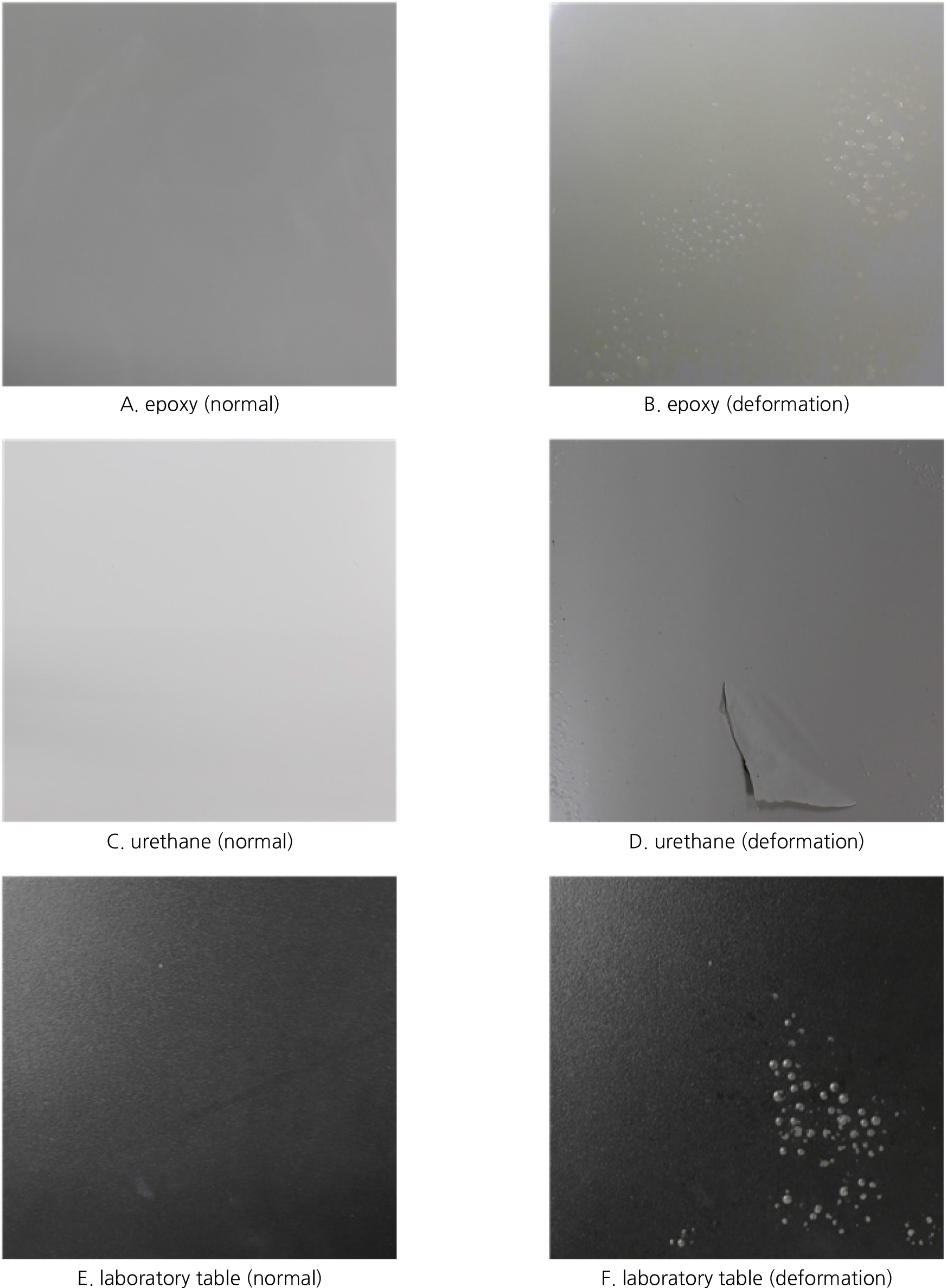INTRODUCTION
소독제의 특성과 효과 분석
Table 1.
Effectiveness and microbial resistance of representative disinfectants marketed in Korea (as of March, 2020)
| Resistancea | Microorganismb | Examplesb |
Trade name (Manufacturer) |
Active ingredient (Dilution concentration, v/v) |
Disinfectant Categoryc |
|---|---|---|---|---|---|
| 1 | Bacterial spores | Bacillus subtilis, B. cereus, Clostridium sporogenes, C. perfrigens |
Rely+OnTM Virkon® (Pharmcle) |
Persulfate compound (1%) |
Peroxygen compound |
|
ZAPS Disinfectant Powder (Pharmcle) |
Monosulfate compound‧ Malic acid (1%) |
Peroxygen compound | |||
| 2 | Mycobacteria | Mycobacterium tuberculosis var. bovis, M. terrae, Nontuberculous mycobacteria |
CaviCideTM (We’zen HealthCare) |
Isopropyl alcohol‧benzethonium chloride concentrate (0%) |
Alcohol, QAC |
|
Melacid (Huen) |
Citric acid (1%) |
Acid | |||
|
SURFA’SAFE (CL Haijin) |
Didecyldimethylammonium chloride (DDAC) 50%‧ Polyhexamethylene biguanide hydrochloride (PHMB) 20% (0%) |
QAC | |||
| 3 | Nonlipid (noneveloped) viruses, Small viruses | Poliovirus, Papillomaviruses, Coxsackievirus, Rhinovirus |
D-125 (Sam Hyun Chemical) |
80% n-Alkyldimethyl ethyl benzyl ammonium chloride‧Alkyldimethyl benzyl ammonium chloride (1:1) (1.54%) |
QAC |
|
DOCTOR SOLUTION HSB021 (Hansung Bio-Chem) |
80% n-Alkyldimethyl ethyl benzyl ammonium chloride‧Alkyldimethyl benzyl ammonium chloride (1:1) (1.54%) |
QAC | |||
| 4 | Fungi | Trichophyton spp., Cryptococcus spp., Candida spp. |
ANIOSURF Premium (CL Haijin) |
Chlorhexidine Gluconate ‧Polyhexamethylene biguanide hydrochloride (PHMB) 20%‧didecyldimethylammonium chloride (DDAC) 50% (0.25%) |
QAC |
| 5 | Vegetative bacteria | Pseudomonas aeruginosa, Staphylococcus aureus, Salmonella choleraesuis, Enterococci |
NOBAC Citric (Heat Runner) |
Citric Acid Hydrate (0%) |
Acid |
|
BIOCLEAN (Jayeon Nature Science) |
Citric Acid Hydrate (1%) |
Acid | |||
|
Distel (HP&C) |
20% Polyhexamethylene biguanide hydrochloride (PHMB)‧ didecyldimethylammonium chloride (DDAC) 50%‧Benzalkonium chloride 50% (0.5%) |
QAC | |||
| 6 | Lipid (enveloped) viruses, Medium-size viruses | Herpes simplex virus, Cytomegalovirus, Respiratory syncytial virus, Hepatitis B virus, Hepatitis C virus, Human immunodeficiency virus, Hantavirus, Ebola virus |
DA CLEAN (Deborah) |
Ethyl alcohol (0%) |
Alcohol |
|
ED Wipes (Wooil C&Tech) |
Benzalkonium chloride 50% (0%) |
QAC | |||
|
Viraclean® (PIC Consulting) |
Benzalkonium chloride (0%) |
QAC | |||
|
PeraCide (Rotor) |
Peroxyacetic Acid (1%) |
Acid |
aResistance is the microbial susceptibility to chemical disinfectants and is classified as 1 (most resistant) to 6 (most susceptible). bMicroorganism and examples are partially modified by The United States Department of Health and Human Services, Center for Disease Control and Prevention (CDC), National Institutes of Health. Biosafety in Microbiological and Biomedical Laboratories (BMBL) 5th ed. Washington D.C.: CDC/NIH, 2009. cDisinfectant category is classified according to chemical properties. QAC; Quaternary ammonium compound.
MATERIALS AND METHODS
시험균주 및 균주 배양
소독제 및 효과 시험 방법
Table 2.
Disinfectant solution condition used in this study
소독제에 따른 표면 재질의 영향 확인
Table 3.
Typical surfaces to be decontaminated by disinfectants in a facility area
| Materiala | Applicationa |
|---|---|
| Stainless steel 304L and 316L grades | Work surfaces, filling equipment and tanks |
| Glass | Windows and vessels |
| Plastic, vinyl | Curtains |
| Plastic, polycarbonate | Insulation coating |
| Lexan® (plexiglass) | Shields |
| Epoxy-coated gypsum | Walls and ceilings |
| Fiberglass-reinforced plastic | Wall paneling |
| Tyvek® | Equipment wraps |
| Terrazzo tiles | Floors |
| Phenolic laminate, Cerastone, Melamin | Laboratory table |
| Uretane | Wall paneling |
Table 4.
Disinfectant solutions used in this study
RESULTS
소독제의 시험 효과
Table 5.
Culture result after disinfectants treatment
소독제에 따른 표면 재질의 영향
 | Fig. 1Surface observation of material after 7 sprays of 30% hydrogen peroxide. (A) (C) (E) The condition before disinfectant treatment is normal. (B) Epoxy surface showed color modulation from 1 time 30% hydrogen peroxide spray. (D) Urethane surface peeling occurred from 4 times 30% hydrogen peroxide spray. (F) The surface of the laboratory table was observed to be bumpy surface from 3 times 30% hydrogen peroxide spray. |




 PDF
PDF Citation
Citation Print
Print


 XML Download
XML Download